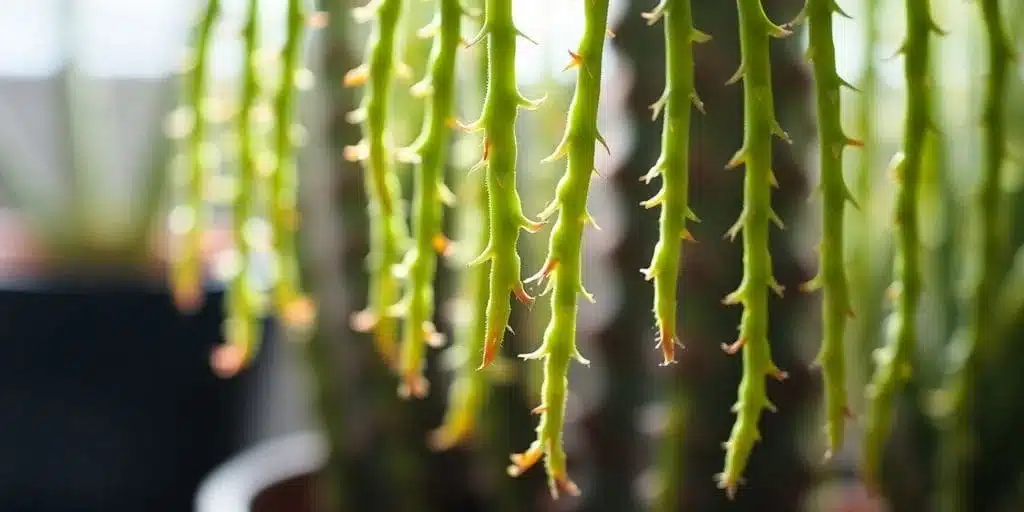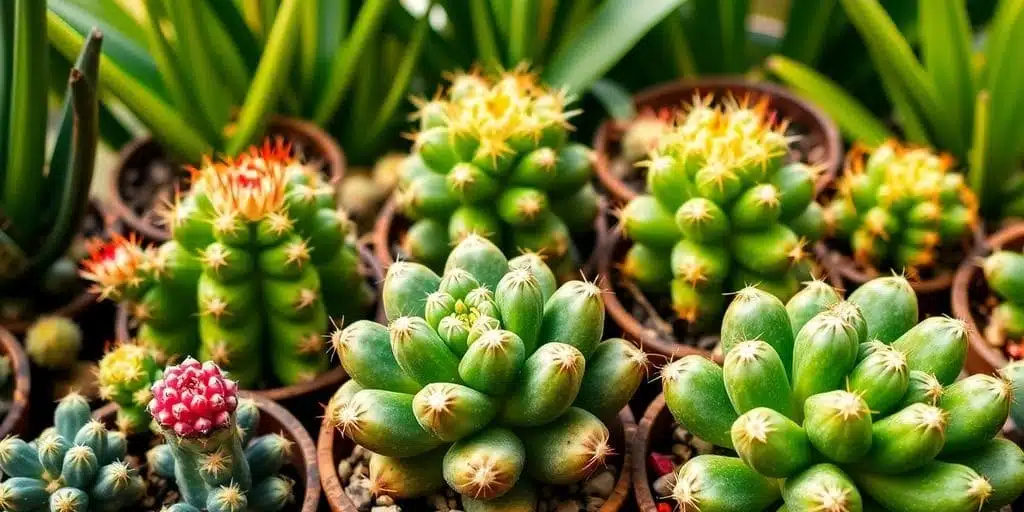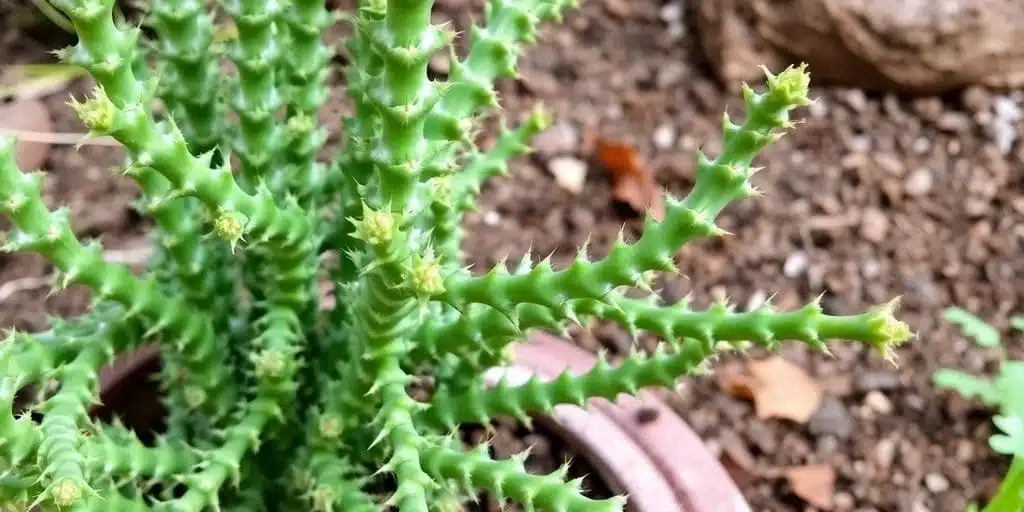Rhipsalis, often called mistletoe cactus, is a unique member of the cactus family that thrives in conditions quite different from your typical desert cactus. Originating from tropical regions, these plants are perfect for those looking to add a touch of the exotic to their indoor plant collection. Unlike its prickly cousins, Rhipsalis prefers a bit of shade and humidity, making it an excellent choice for indoor gardening enthusiasts.
Table of Contents
Understanding Rhipsalis: A Unique Cactus
Origins and Natural Habitat
Rhipsalis is a fascinating genus of the cactus family, standing out as the only cactus that naturally grows outside the Americas. You’ll find these epiphytic plants thriving in the rainforests of Central and South America, as well as remote parts of Africa and Asia. Unlike most cacti, Rhipsalis prefers the humid, shaded canopy of tropical forests, where it can spread its trailing stems along tree branches.
Distinctive Features
Unlike the typical desert cactus, Rhipsalis is known for its lack of spines and its ability to tolerate less sunlight. This “jungle cactus” grows long, thin stems that can cascade beautifully when potted. In its natural habitat, thi cactus can produce vibrant flowers and berries, though replicating these conditions indoors can be challenging.
Common Varieties of Rhipsalis
There are numerous varieties, each with its unique charm:
- Rhipsalis clavatum: Known for its thick, club-shaped stems.
- Rhipsalis agudoensis: Features slender, hair-like stems.
- Rhipsalis capilliformi: Has fine, hair-like branches.
- Rhipsalis pilocarpa: Displays soft, bristle-covered stems.
- Rhipsalis cereuscula: Known for its clustered, pencil-thin stems.
- Rhipsalis ewaldiana: Features elongated, cylindrical stems.
- Rhipsalis paradoxa: Recognized for its zig-zag patterned stems.
- Rhipsalis mesembryanthemoide: Exhibits fleshy, bead-like segments.
- Rhipsalis ramulosa: Known for its flat, reddish stems.
Rhipsalis, often referred to as the mistletoe cactus, is a unique and versatile addition to any plant collection. Its adaptability to various light conditions and its forgiving nature make it an excellent choice for both novice and experienced plant enthusiasts.
Optimal Light Conditions

Importance of Indirect Light
Often called the mistletoe cactus, thrives in environments where it receives plenty of indirect light. Direct sunlight, especially during the afternoon, can be harmful, leading to scorched leaves. Position your Rhipsalis a few feet away from a window where it can bask in filtered sunlight. This setup mimics its natural habitat under the canopy of trees, ensuring the plant remains healthy and vibrant.
Avoiding Sunburn and Scorching
One of the biggest threats to Rhipsalis is excessive direct sunlight. Prolonged exposure can cause sunburn, evident by red or brown patches on the leaves. To prevent this, avoid placing your plant in a spot where it receives harsh midday sun. If you notice signs of sunburn, consider moving the plant to a shadier location or using a sheer curtain to diffuse the light.
Adapting to Low Light Environments
While Rhipsalis prefers bright, indirect light, it can adapt to lower light conditions. However, growth may slow, and flowering might be affected if the light is too dim. If your plant is in a low-light area, consider giving it a “light vacation” by occasionally moving it to a brighter spot for a few days. This strategy helps maintain its health and encourages more robust growth.
Watering : Balancing Moisture
Signs of Overwatering and Underwatering
Rhipsalis, though a cactus, thrives in a balance of moisture. Overwatering is a common mistake that can lead to root rot. Watch out for yellowing stems or mushy roots, which indicate too much water. On the flip side, underwatering can cause the tendrils to droop and lose their firmness. If they turn brown and crispy, it’s a sign you’ve waited too long. However, this cactus is forgiving and can bounce back once watered adequately.
Best Practices
- Check Soil Moisture: Before watering, check the soil’s moisture level. If it’s dry a couple of inches below the surface, it’s time to water.
- Water Sparingly: Use a small amount of water, ensuring the soil is moist but not soaked. Let the top layer dry out before the next watering.
- Adjust for Seasons: In winter, reduce watering frequency as growth slows down.
Using Humidity to Your Advantage
Rhipsalis enjoys a humid environment, reminiscent of its natural habitat. You can use a humidity tray or mist the plant occasionally to boost moisture levels. This is particularly helpful during dry seasons or if your home has low humidity.
Rhipsalis, with its white flower blooms, can thrive indoors with the right care. Keep an eye on moisture levels, and your plant will reward you with lush growth.
Soil and Potting
Choosing the Right Potting Mix
Selecting the appropriate potting mix is crucial for Rhipsalis. These cacti thrive in a well-draining mix that mimics their natural epiphytic conditions. A blend containing shredded bark, perlite, and sphagnum moss works well. Alternatively, a standard houseplant potting mix enriched with perlite at a ratio of 60% potting mix to 40% perlite can also be effective. The key is ensuring good aeration and slight acidity.
Repotting Guidelines
Rhipsalis should be repotted once the roots fill their pot, typically every year or so. They prefer a snug container but will need a slightly larger pot once they outgrow the current one. The best time to repot is in spring when the plant is ready to take advantage of the longer daylight hours. Be sure to choose a pot with good drainage to prevent water from sitting around the roots.
For a successful repotting process, check out this comprehensive guide from the University of Georgia.
Benefits of Terracotta Pots
Terracotta pots are ideal for Rhipsalis because they allow for better aeration and reduce the risk of root rot. These pots help the soil condition remain optimal by allowing excess moisture to evaporate through their porous walls. This feature is particularly beneficial in maintaining the delicate balance of moisture that Rhipsalis require.
Temperature and Humidity Requirements

Ideal Temperature Range
Rhipsalis, unlike your typical desert cactus, thrives in warmer environments. Ideally, you want to keep these plants at temperatures above 50°F. They love a cozy spot, and if you’re in a region where frost is common, keeping them indoors during the colder months is crucial. If you notice any signs of frost damage, like blackened stems, it’s time to bring them inside.
Maintaining Humidity Levels
While Rhipsalis isn’t extremely picky about humidity, it does appreciate a bit more moisture in the air than other cacti. Aim for a humidity level of around 40%, which is generally the average in most homes. However, during the winter months, when heating systems tend to dry out the air, you might want to boost the humidity a bit. Consider using a humidifier or placing the plant on a tray filled with pebbles and water, ensuring the pot isn’t sitting directly in water.
Protecting from Frost
Frost can be a real threat to Rhipsalis. If you’re leaving them outside, make sure they’re in a sheltered spot, away from cold drafts. When frost is predicted, it’s best to bring them inside or cover them with a frost cloth. Remember, Rhipsalis is a jungle cactus, so it doesn’t have the same frost tolerance as its desert cousins. Keeping them safe from extreme cold will help ensure they stay healthy and vibrant.
Fertilizing for Healthy Growth
Choosing the Right Fertilizer
Selecting the appropriate fertilizer is key to nurturing a healthy plant. A balanced liquid fertilizer, like a 20-20-20, works wonders for Rhipsalis. It provides equal parts nitrogen, phosphorus, and potassium, which are essential for robust growth. During the blooming season, consider switching to a fertilizer with higher potassium content to encourage those vibrant, coloured pink blooms.
Frequency of Fertilization
Regular feeding is crucial for keeping your Rhipsalis thriving. Apply a diluted fertilizer every two weeks during the active growing season, typically from spring to early fall. Avoid fertilizing in the winter months, as the plant’s growth slows down, and it requires less nourishment. Remember, over-fertilization can harm your plant, so stick to the recommended schedule.
Encouraging Blooms with Nutrients
To boost blooming, ensure your Rhipsalis receives the right nutrients. Potassium-rich fertilizers can enhance flower production and overall plant vigor. If you notice a lack of blooms, evaluate your fertilization routine and adjust accordingly. Always water your plant before applying fertilizer to prevent root burn.
Consistent and mindful fertilization ensures your Rhipsalis remains a stunning and healthy addition to your indoor garden.
Common Pests and Diseases
Identifying Common Pests
Rhipsalis plants, including popular varieties , often encounter pesky invaders. Mealybugs are the most frequent offenders, easily identified by their white, cotton-like appearance. These pests love hiding in nooks and crannies, especially in leaf axils or between stems and leaves. Regular inspections can help catch these bugs early. Other pests to watch for include aphids, red spider mites, and thrips.
Preventing and Treating Infestations
To keep your Rhipsalis pest-free, consider these prevention tips:
- Increase Airflow: Good air circulation can deter many pests, especially mealybugs.
- Regular Cleaning: Dusting leaves and stems can prevent pests from settling in.
- Natural Remedies: Use organic solutions like neem oil or insecticidal soap for treatment.
If pests have already settled in, you can manually remove them with a cotton swab dipped in alcohol or introduce natural predators like ladybugs to your plant environment.
Recognizing Signs of Disease
While Rhipsalis is generally resilient, it’s not immune to disease. Overwatering is a common issue, leading to root rot. Signs include yellowing leaves and a soft, mushy stem. To prevent this, ensure your plant has well-draining soil and avoid letting it sit in water.
“Rhipsalis are tough, but even they need a bit of attention to stay healthy. Keep an eye out for changes, and your plant will thrive.”
By keeping a close watch on your Rhipsalis and maintaining proper care routines, you’ll ensure these unique cacti continue to flourish.
Pruning and Propagation Techniques

When and How to Prune
Pruning Rhipsalis is pretty straightforward. It’s not a plant that demands a lot of trimming, but occasional snipping can help keep it looking neat. Focus on removing any dead or diseased stems to promote healthy growth. Always use clean, sterilized scissors or pruners to avoid spreading disease. If your Rhipsalis is getting too long, you can trim back the stems to maintain your desired shape.
Methods of Propagation
Rhipsalis can be propagated through stem cuttings or division. Stem cuttings are the most popular method because they root quickly and easily. Here’s a simple guide to get you started:
- Select a Healthy Stem: Choose a stem that’s about 4-6 inches long. Make sure it’s healthy and free from any signs of disease.
- Prepare the Cutting: Use sterilized scissors to cut the stem. Let the cut end dry and callous for a few days.
- Planting: Insert the dried end into a pot with moist cactus potting mix. Keep the pot in a bright spot, but away from direct sunlight.
- Cover and Care: Cover the pot with a plastic bag to create a mini-greenhouse effect. Remember to remove the bag daily for a few minutes to allow air circulation.
Alternatively, you can propagate Rhipsalis by dividing the plant. This involves gently separating sections of the plant, ensuring each piece has enough roots attached. This method is great for larger plants that need to be split.
Encouraging New Growth
To encourage new growth, make sure your Rhipsalis gets enough indirect light and is watered properly. Humidity can also play a role, so consider misting the plant occasionally. Fertilize during the growing season with a balanced liquid fertilizer, but don’t overdo it. Too much fertilizer can harm the plant rather than help it.
Pruning and propagation might seem daunting, but with a bit of patience and care, you’ll find it’s a rewarding way to expand your plant collection. Whether you’re trimming back overgrown stems or nurturing new cuttings, your Rhipsalis will thrive with the right attention.
For more on gentle pruning techniques and the importance of creating habitats for wildlife, check out our guide on recommended shrubs for various U.S. climates.
Conclusion
Caring for a Rhipsalis cactus might seem a bit different from your typical desert cactus, but it’s totally doable. Just remember, they love their bright, indirect light and a bit more humidity than you’d expect for a cactus. Keep the soil moist but not soggy, and don’t forget to give them a little fertilizer boost now and then. With the right care, your Rhipsalis will thrive and add a unique touch to your plant collection. So, whether you’re a seasoned plant parent or just starting out, these jungle cacti can be a rewarding addition to your home. Happy planting!
Frequently Asked Questions
What kind of light is best for Rhipsalis?
Rhipsalis prefers bright, indirect light. Avoid placing it in direct sunlight, as this can cause sunburn. A spot near a window that gets filtered light is ideal.
How often should I water my Rhipsalis?
Water your Rhipsalis when the top inch of soil feels dry. Ensure the pot drains well to prevent water from sitting at the bottom, which can cause root rot.
What type of soil should I use for Rhipsalis?
Use a well-draining cactus mix or a potting mix with added sand and organic material. This helps mimic their natural environment where they grow on trees or rocks.
Can I grow Rhipsalis outdoors?
Rhipsalis can be grown outdoors in warm climates with temperatures above 50°F. Ensure they are in a shaded area to protect them from direct sunlight.
How do I fertilize Rhipsalis?
Use a balanced, diluted fertilizer every two weeks during the growing season. This helps encourage blooms and overall healthy growth.
What should I do if my Rhipsalis has pests?
If you notice pests like spider mites or mealybugs, wipe them off with a damp cloth. For larger infestations, consider using an eco-friendly pesticide.


3 thoughts on “Rhipsalis: Essential Tips for Growing This Unique Cactus”